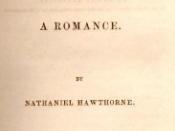In life, when people know little about one, often the worst may be inferred. The novel, The Scarlet Letter, by Nathaniel Hawthorne, has a central theme revealed in the final chapter of the novel which relates to this theory. The author, speaking directly to the reader says, "Be true! Show freely to the world if not your worst, yet some trait whereby the worst may be inferred." Throughout the novel, the protagonists, Hester Prynne and Arthur Dimmesdale, face experiences and challenges which relate to the theme of truth and that it is a better alternative to allowing people to make misinformed inferences. These challenges include Dimmesdale's inability to tell the truth about his adultery and Hester's endeavor in hiding the truth about both Dimmesdale and Chillingworth. Their public actions, self-images and relationships with society display this theme throughout the novel.
Hester's and Dimmesdale's views of themselves prove that one should show to the world their true self.
Hester is sent to live on the outskirts of the town, isolated from the rest of the community after she is accused of committing adultery, an illicit offense in the puritan community. It is here that she begins to believe she deserves to live this way. Dimmesdale, on the other hand, is tormented by his inability to confess. He was the man of who Hester refused to reveal a name that was the man who she committed adultery with. Dimmesdale despises himself and often fasts until "his knees trembled beneath him as an act of penance" (132) or whips himself. Dimmesdale does everything he can to try to find just one minute of peace from his guilty heart and conscience. By keeping the truth from the world Dimmesdale is slowly killing himself.
The way the protagonists conduct themselves in front of the...


